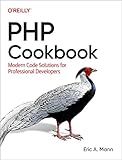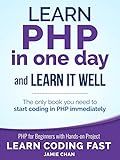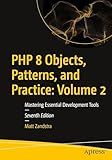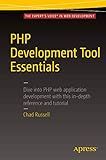Best PHP Tools to Buy in December 2025

PHP Cookbook: Modern Code Solutions for Professional Developers



Kaisi Professional Electronics Opening Pry Tool Repair Kit with Metal Spudger Non-Abrasive Nylon Spudgers and Anti-Static Tweezers for Cellphone iPhone Laptops Tablets and More, 20 Piece
-
COMPREHENSIVE 20-PIECE KIT FOR ALL TECH REPAIR NEEDS.
-
DURABLE STAINLESS STEEL TOOLS GUARANTEE LONGEVITY AND RELIABILITY.
-
INCLUDES CLEANING CLOTHS FOR A POLISHED FINISH AFTER REPAIRS.



PHP: Learn PHP in One Day and Learn It Well. PHP for Beginners with Hands-on Project. (Learn Coding Fast with Hands-On Project Book 6)



PHP 8 Objects, Patterns, and Practice: Volume 1: Mastering OO Enhancements and Design Patterns



PHP 8 Objects, Patterns, and Practice: Mastering OO Enhancements, Design Patterns, and Essential Development Tools



iFixit Jimmy - Ultimate Electronics Prying & Opening Tool
- VERSATILE TOOL: PERFECT FOR TECH REPAIRS AND HOUSEHOLD PROJECTS ALIKE.
- PRECISION CONTROL: ERGONOMIC HANDLE FOR EFFORTLESS AND ACCURATE REPAIRS.
- LIFETIME WARRANTY: TRUSTWORTHY QUALITY BACKED BY IFIXIT'S LIFETIME GUARANTEE.



PHP 8 Objects, Patterns, and Practice: Volume 2: Mastering Essential Development Tools



Expert PHP 5 Tools



PHP Development Tool Essentials



Vintage PHP Backend Laravel CodeIgniter Developers T-Shirt
- RETRO PHP DESIGN: PERFECT GIFT FOR DEVELOPERS AND CODERS!
- LIGHTWEIGHT, CLASSIC FIT: COMFORTABLE FOR EVERYONE-MEN, WOMEN, KIDS!
- DURABLE DOUBLE-NEEDLE SEAMS: BUILT TO LAST FOR EVERYDAY WEAR!


To remove duplicates in a PHP array, you can use the array_unique() function. This function takes an array as input and returns a new array with only unique values.
Here's an example of how to remove duplicates from an array:
$array = array("apple", "banana", "orange", "apple", "grape", "banana");
$uniqueArray = array_unique($array);
print_r($uniqueArray);
Output:
Array ( [0] => apple [1] => banana [2] => orange [4] => grape )
In the above example, the array_unique() function eliminates the duplicate elements "apple" and "banana" from the original array.
By default, array_unique() preserves the keys of the original array. If you want to reset the keys and create a new array with consecutive integer keys, you can use the array_values() function:
$newArray = array_values($uniqueArray);
print_r($newArray);
Output:
Array ( [0] => apple [1] => banana [2] => orange [3] => grape )
In the updated array, the keys have been reset to consecutive integers starting from 0.
How can you remove duplicates from a multidimensional array using a loop?
To remove duplicates from a multidimensional array using a loop, you can follow these steps:
- Create an empty result array to store the unique values.
- Iterate through each element in the input multidimensional array using nested loops or a combination of for loops.
- Check if the element already exists in the result array.
- If the element does not exist in the result array, add it to the result array.
- Finally, return the result array without duplicates.
Here's an example in Python:
def remove_duplicates(arr): result = [] # Empty result array for sublist in arr: for item in sublist: if item not in result: # Check if item already exists in the result array result.append(item) return result
Example usage
input_array = [[1, 2, 3], [4, 3, 2], [5, 6, 7], [1, 2, 3]] output_array = remove_duplicates(input_array) print(output_array) # Output: [1, 2, 3, 4, 5, 6, 7]
In this example, we iterate through each element of the input array using nested loops. We check if the element is already present in the result array, and if not, we append it to the result array. The final result array contains unique elements without any duplicates.
Are there any built-in PHP functions to remove duplicates from an array?
Yes, there are built-in PHP functions you can use to remove duplicates from an array. Two commonly used functions are array_unique() and array_flip().
- array_unique() function: This function returns an array with duplicate values removed. It compares the values of the array elements and keeps only the first occurrence of each unique value.
Here's an example of using array_unique():
$originalArray = [1, 2, 2, 3, 4, 4, 5]; $uniqueArray = array_unique($originalArray); print_r($uniqueArray);
Output:
Array ( [0] => 1 [1] => 2 [3] => 3 [4] => 4 [6] => 5 )
- array_flip() function: This function swaps the keys with their corresponding values in the array. Since PHP does not allow duplicate keys, this effectively removes duplicate values.
Here's an example of using array_flip():
$originalArray = [1, 2, 2, 3, 4, 4, 5]; $uniqueArray = array_flip(array_flip($originalArray)); print_r($uniqueArray);
Output:
Array ( [0] => 1 [1] => 2 [2] => 3 [3] => 4 [4] => 5 )
Both functions can be used depending on your specific requirements and array structure.
What happens if an array contains both string and numeric keys, and you use array_unique()?
If an array contains both string and numeric keys, using the array_unique() function will only compare the values associated with the keys without considering the keys themselves.
When array_unique() is called on such an array, it will keep the first occurrence of each unique value, regardless of whether the keys are strings or numeric. The resulting array will have the original keys associated with the unique values. However, if there are multiple values with the same content, only the first occurrence will be kept, and the subsequent occurrences will be removed.
Here is an example to illustrate this behavior:
$array = array( 0 => 'apple', '1' => 'banana', '2' => 'apple', '3' => 'pear', 'four' => 'pear', 5 => 'banana' );
$result = array_unique($array);
print_r($result);
Output:
Array ( [0] => apple [1] => banana [3] => pear )
In the example above, the keys '2' and 'four' are ignored, and only the unique values 'apple', 'banana', and 'pear' are kept. The resulting array preserves the original keys associated with those unique values.
Can you remove duplicates from an array by converting it to a string and back to an array?
Yes, you can remove duplicates from an array by converting it to a string and then back to an array. Here's an example of how you can do it in JavaScript:
let array = [1, 2, 3, 4, 4, 5, 5]; // Example array with duplicates
let uniqueArray = Array.from(new Set(array)); // Convert to a set to remove duplicates, then convert back to an array
console.log(uniqueArray); // Output: [1, 2, 3, 4, 5]
In this example, we convert the array to a Set using new Set(array), which automatically removes duplicates since Set only allows unique values. Then, we use Array.from() to convert the set back to an array.
Keep in mind that this method will only work for arrays containing primitive values (e.g., numbers, strings, booleans). If your array contains objects or arrays as its elements, the duplicates won't be removed using this approach.
Is it possible to remove duplicates from an array using a callback function?
Yes, it is possible to remove duplicates from an array using a callback function.
Here is an example of how you can achieve this using JavaScript:
function removeDuplicates(array, callback) { return array.filter((element, index, arr) => index === arr.findIndex((t) => callback(t, element)) ); }
const inputArray = [1, 2, 3, 4, 1, 2, 5]; const result = removeDuplicates(inputArray, (a, b) => a === b); console.log(result); // Output: [1, 2, 3, 4, 5]
In this example, the removeDuplicates function accepts an array and a callback function as parameters. The filter method is then used on the array to filter out the duplicates.
The callback function is used inside the findIndex method to compare each element of the array with the current element being iterated. If the callback function returns true for any other element, it means that there is a duplicate and it is filtered out from the final result returned by the filter method.
Note that the example assumes that the array consists of primitive values like numbers or strings. If you have an array of objects and you want to remove duplicates based on a specific property, you would need to modify the callback function accordingly.
Can you remove duplicates from a 2D array in PHP?
Yes, you can remove duplicates from a 2D array in PHP using the following method:
function removeDuplicatesArray($arr) { $uniqueArray = array();
foreach($arr as $subArray) { $serializedSubArray = serialize($subArray); $uniqueArray[$serializedSubArray] = $subArray; }
$uniqueArray = array_values($uniqueArray);
return $uniqueArray; }
Here, the removeDuplicatesArray function takes the 2D array as an argument and creates a new associative array $uniqueArray. It serializes each subarray and uses it as a key in the $uniqueArray. This ensures that duplicate subarrays are automatically removed. Finally, the function uses array_values to reset the keys and returns the resulting unique array.
Here's an example usage:
$arr = array( array(1, 2, 3), array(4, 5, 6), array(1, 2, 3), array(7, 8, 9) );
$uniqueArr = removeDuplicatesArray($arr);
print_r($uniqueArr);
Output:
Array ( [0] => Array ( [0] => 1 [1] => 2 [2] => 3 )
\[1\] => Array
(
\[0\] => 4
\[1\] => 5
\[2\] => 6
)
\[2\] => Array
(
\[0\] => 7
\[1\] => 8
\[2\] => 9
)
)
As you can see, the duplicates [1, 2, 3] were removed from the 2D array.
Are there any limitations to removing duplicates from large arrays in PHP?
Yes, there are some limitations when removing duplicates from large arrays in PHP:
- Memory Limit: PHP has a memory_limit configuration that limits the amount of memory a script can consume. When working with large arrays, removing duplicates can require a significant amount of memory, which may exceed the memory_limit and cause the script to terminate prematurely.
- Execution Time: Removing duplicates from large arrays can be a time-consuming process, especially if the array size is extensive. PHP has a max_execution_time configuration that determines the maximum time a script can run. If removing duplicates takes longer than this specified time, the script will be terminated by PHP.
- Performance: Removing duplicates from large arrays can have a significant impact on performance. As the array size increases, the algorithm used to remove duplicates becomes more crucial. Inefficient algorithms can result in slower execution times, making the process unfeasible for extremely large arrays.
- Key Preservation: Depending on the method used to remove duplicates, the keys associated with array elements may not be preserved. For example, using array_unique() function in PHP reindexes the array, resulting in the loss of original keys. This limitation may impact the functionality of the code that relies on specific key-value pairings.
To overcome these limitations, it is advisable to optimize the algorithm used for removing duplicates, consider using more efficient data structures like sets or hashes, or utilize external tools and databases for handling large datasets.
Can you remove duplicates from an array while keeping the keys intact?
Yes, you can remove duplicates from an array while keeping the keys intact. Here is an example of how you can achieve this in Python:
def remove_duplicates(arr): new_arr = [] seen = set() for item in arr: if item not in seen: seen.add(item) new_arr.append(item) return new_arr
Example usage:
arr = [1, 2, 3, 3, 4, 2, 5] new_arr = remove_duplicates(arr) print(new_arr)
Output: [1, 2, 3, 4, 5]
In this example, we create a new empty list called new_arr to store the unique elements. We also initialize an empty set called seen to keep track of the elements we have already encountered.
We iterate through each item in the original array arr, and if the item has not been seen before (i.e., not in the seen set), we add it to both the new_arr list and the seen set. This way, we maintain the original order of the elements while removing duplicates.
Finally, we return the new array new_arr that contains unique elements with the original key order intact.
Why would you want to remove duplicates from a PHP array?
There are several reasons why you may want to remove duplicates from a PHP array:
- Data consistency: Having duplicates in an array can lead to inconsistent data and potential errors in data processing or analysis. Removing duplicates ensures that each value appears only once, ensuring data integrity.
- Improved performance: If you are performing operations that involve searching or iterating over the array, removing duplicates can significantly improve performance by reducing the number of elements to process.
- Memory efficiency: Removing duplicates can help conserve memory resources, especially when dealing with large arrays. Storing unique values only reduces the memory footprint of the array.
- Data presentation: When presenting data to the user, duplicates are often unnecessary and may confuse or mislead the audience. Removing duplicates can provide a cleaner, more readable output.
- Eliminating redundancy: Duplicates in an array can indicate redundant or unnecessary data. Removing duplicates helps to streamline the array and focus on the unique and relevant elements.
Overall, removing duplicates from a PHP array helps ensure data consistency, improve performance and memory efficiency, enhance data presentation, and eliminate unnecessary redundancy.
